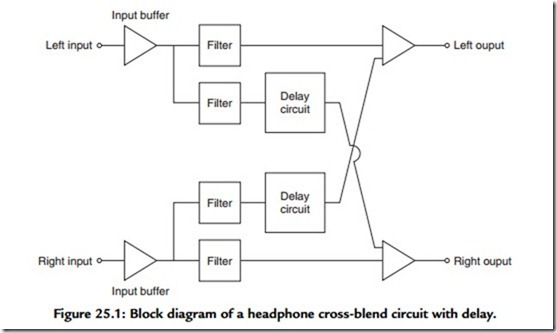Pros and Cons of Headphone Listening
Good headphones, having no box resonances, can produce a less colored sound than loudspeakers, even today. Headphones have the further acoustic advantage of not exciting room resonances and thus giving the listener a more accurate sense of the recorded acoustics.
However, headphones do not seem capable of producing the sheer impact available from loudspeakers, and unfortunately, stereo images are formed unrealistically inside the head due to the way stereo is recorded for loudspeaker reproduction.
None of these disadvantages matter much if your prime requirement is privacy or, in the case of Walkmans, portability. You can cheerfully blast away at your eardrums without inflicting your musical tastes on others. The closed back type of headphone in particular is very good at containing the sound away from others and insulating the listener from outside sounds.
Dummy Heads
One way of overcoming the sound-in-the-head phenomenon that occurs when listening to normal speaker-oriented stereo through headphones is to record the signal completely differently using microphones embedded in artificial ears in a dummy human head.
This “dummy head”-recording technique effectively ensures that each listener’s ear receives a replica of the sound at the dummy head’s ear positions. The result is much greater realism, with sounds perceivable behind, to the side, and in front of the listener, but not inside the head.
The exact location of sound images depends to some extent on how similar the listeners’ ears are to the dummy’s, but even using a plastic disc for a head-like baffle between two microphones gives very passable results.
Why then has this not been taken up more widely? In a word, the answer is loudspeakers. Dummy head recordings do not sound at all convincing through loudspeakers due to the blending of sounds between the microphones that occurs around the dummy head during recording. The only way to listen to dummy-head recordings with loudspeakers is to sit immediately between them and listen as if they were headphones, which is not exactly practical.
Nevertheless, listening to good dummy-head recordings through fine headphones is an experience that is not easily forgotten. The sound can be unnervingly real.
Cross-Blending
Other ideas used to try to reduce or eliminate the unwanted images in the head with headphone stereo have centered around cross-blending between the two stereo channels to emulate the influence the listener’s head would normally have. In other words, to reproduce and imprint electronically the effect of the listener’s head on the stereo signals.
The head has two main effects. First, it acts as a baffle, curtailing the high frequencies heard by the ear furthest from the sound. Second, it introduces a time delay (or rotating phase shift with increasing frequency) to the sound heard by the furthest ear from the source.
Naturally such a simulation can only be approximate. Basic circuits simply cross-blend filtered signals between channels to emulate the absorptive factor. More complex circuits have been devised to introduce a time delay, in addition to high-frequency absorption, into the cross-blended signals. This is reported to be more effective, lending a more natural out-of-the-head sound to headphone listening with normal stereo recordings.
Biphonics
There were attempts in the 1970s to emulate dummy-head listening when using loudspeakers. The technique was known as biphonics and the idea was to cross-blend
signals feeding two front-positioned loudspeakers to give an all-round effect, with sounds appearing to come from behind the listener as well as in front (Figure 25.1). Surprisingly, the system worked, but only when the listener’s head was held within a very limited space in front of the speakers. Predictably, the idea did not catch on.
